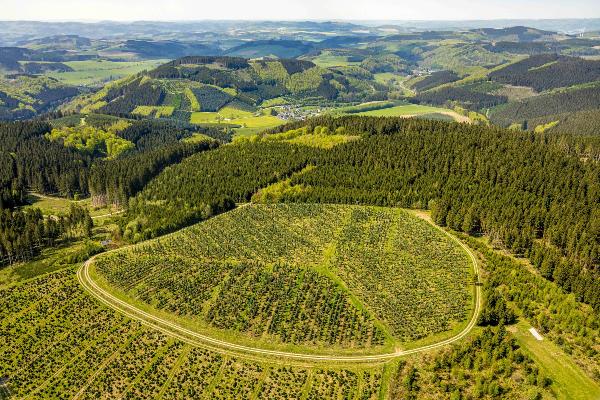The Paris Agreement calls on us to limit global warming to 1.5 degrees Celsius above pre-industrial levels. To reach this goal, we need to reduce CO₂ emissions and remove existing CO₂ from the atmosphere. A team led by LMU scientists Yiannis Moustakis and Julia Pongratz has now demonstrated that large-scale afforestation/reforestation (AR) can make an important contribution to such efforts. Simulations by the researchers show that AR could reduce peak and end-of-century temperature and shorten the period during which global temperature exceeds the 1.5-degree target, as they report in the journal Nature Communications.
AR is currently the most frequently deployed method of removing carbon dioxide from the atmosphere. “Overall, the international community has already announced ambitious AR goals of up to 490 million hectares by 2060, and this figure is likely to increase even further as more countries present their long-term plans. We wanted to find out how strongly these measures can influence the climate,” says Moustakis. “Investigating their effects in detail requires the use of cutting-edge models which can represent an interactive carbon cycle that takes into account various processes and feedbacks.”
Modeling with more than 1,200 scenarios
The researchers employed an unprecedented number of more than 1,200 scenarios from Integrated Assessment Models (IAMs) – models that link climate policies with future energy, economic, and land use pathways – as well as restoration priority maps and biodiversity data to develop an ambitious AR scenario. In this way, the scientists were able to take technical and economic challenges into account, while also considering the impact on biodiversity and land availability in the countries.
Based on this, the researchers developed a scenario that foresees 595 million hectares (Mha) of afforested/reforested land by 2060 and 935 Mha by 2100. “This is definitely an ambitious scenario, and one could of course question the feasibility of such ambitious efforts. However, this is not arbitrarily chosen. We tried to develop a scenario that is rather in the range of country peldges globally, extend it to the end of the century, and constrain its spatial and temporal features by technoeconomic considerations, while minimizing the impact on biodiversity. ,” emphasizes Moustakis.
Next, the scientists analyzed this AR scenario with the Earth System Model of the Max Planck Institute for Meteorology, which can simulate the effects of afforestation/reforestation on the climate. The simulations used an overshoot scenario – that is to say, a climate scenario where the emission trajectory is such that average global temperature goes beyond the 1.5°C target before falling back below this level around the end of the century. “As delays in drastic climate action persist, such scenarios are becoming increasingly probable,” explains Moustakis.
Launch of nationwide CO₂ removal research program CDRterra at LMU
Read more
Average temperature falls, overshoot duration shortens
The results of the simulations show that ambitious AR measures could significantly influence the climate. Specifically, AR could reduce global peak temperature at mid-century by 0.08°C, while lowering end-of-century temperature by 0.2°C compared to a scenario without AR. In addition, the measures could shorten the time during which global temperature overshoots the 1.5-degree target by 13 years. The footprint of AR on global temperature becomes evident already by 2052.
Another important finding of the simulations is that the side effects of AR on climate do not outweigh their positive effects of taking up CO2: AR not only has effects on carbon sequestration, but also changes physical properties of the Earth’s surface, such as the albedo – the ability of the Earth’s surface to reflect sunlight – and the evaporation of water. This can lead to warming in some regions. But as the study shows, the cooling effect of CO₂ absorption predominates, as the local warming caused by AR is not strong enough to cancel out the cooling effect.
“These results show that global AR can in fact make an important contribution to mitigating climate change, when applied at the large sale,” says Moustakis. “But it is not a panacea and must be viewed in a more comprehensive framework that takes socioeconomic trade-offs equally into account. Planting a forest could create jobs, revenue, and promote ecosystem services, but it could also deprive people’s livelihood, exacerbate poverty, financially or physically displace people, and disturb local food networks.”
Yiannis Moustakis, Tobias Nützel, Hao-WeiWey, Wenkai Bao, Julia Pongratz: Temperature overshoot responses to ambitious forestation in an Earth System Model. Nature Communications 2024.


